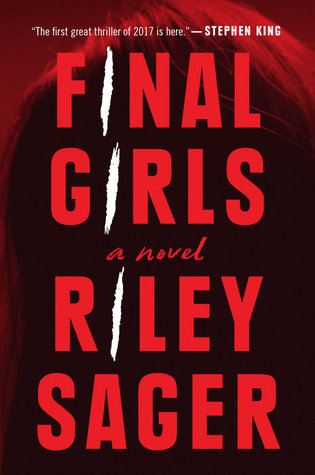Riley Sager’s Final Girls modernizes a horror trope and spins it into a character piece about what happens after horror hits home. The “final girl,” a notion well known to slasher fans, is the sole survivor of a horror film. She’s the one woman who bests the killer to survive whatever horrifying ordeal was laid out in front of her. Ten years ago, Quincy Carpenter went on vacation with five friends and came back alone, the only survivor of a cabin-in-the-woods style massacre. The media pegged her as a Final Girl, along with two others: Lisa, whose nine sorority sisters were murdered by a college dropout’s knife, and Sam, a housekeeper who went up against the deranged Sack Man during her motel shift. The women are attempting to lay their nightmares to rest, yet despite the media’s attempts, they’ve never met.
Quincy is doing OK in life, repressing a lot of her horrific experience thanks to a Xanax prescription and her caring, but far too safe boyfriend, Jeff. She’s got emotional support through Coop, the police officer who saved her life on the scene. Her memory won’t allow her to recall the events of that night; she can’t even picture “Him.” She lives in her ignorant baking-blog bliss until Lisa is found dead, wrists slit from an apparent suicide. Sam then shows up on Quincy’s doorstep, throwing her comfortable post-trauma life out of whack, and forcing Quincy to relive the terror she’s desperately trying to snuff out. When new details come to light about Lisa’s death, Quincy’s painkiller addition worsens and her life is turned upside down as she tries to pick apart Sam’s truths from her lies, evade the police and tactless reporters, and remember what happened that fateful night 10 years ago.
Final Girls does a lot of things right in terms of sticking true to the genre. The three separate massacres are well painted, and refuse to shy away from the bloody bits that might make some uncomfortable. However, the novel, as a whole, is more of a Thriller than Horror story. What makes up the bulk of the book, its slower, bloated middle, is a character-building drama with thriller elements. The presence of Sam certainly throws her for a loop, as the two start shoplifting, accosting strangers in Central Park, and getting into other PTSD-related shenanigans. We follow Quincy’s life as it rapidly spirals downward, outlining what someone goes through after the blood has been mopped up.
There’s a theme of rebirth present throughout, though Quincy’s character can get a little annoying. Yes, she’s successfully reinvented herself, but she’s done so in a completely fabricated way. She becomes yet another popular Instagrammer hiding behind pretty photos of cakes, cookies and pies. She avoids coming to terms with her past until she’s absolutely forced to by Sam. Can we really give her credit for her own redemption and growth? I’m not sure. Quincy’s path to recovering her memory grows tiresome (amnesia storylines always test the patience), and while the presence of Sam definitely sends shockwaves throughout, the reader is left wading in this middle ground a little too long while waiting for the satisfying end.
The story’s action-packed, whodunnit ending does have enough twists and turns to make the read a recommended one, but Horror buffs shouldn’t go in expecting a 350-page slasher tale. That’s not quite what Sager delivers. Rather, Final Girls focuses on the aftermath of it all, and what happens when we’re forced to confront the one thing in life we’ve been running from. At its best, Final Girls can be a page-turner, but this story is definitely more Gillian Flynn than John Carpenter. Grade: B



